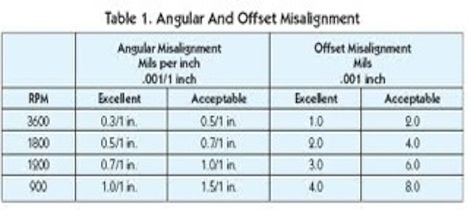VibrAlign’s Alignment Tolerance Table closely parallels many other alignment companies and general industrial standards. One thing almost all alignment tolerance tables agree on is that the faster the machines rotate, the more closely the shafts must be aligned.
Most mechanics know this, but don’t know why. The most common answers I hear are balance or centrifugal force. But the reason tolerances “tighten up” as speed increases is due to deflection.
When coupled machines are misaligned, there are forces existing which would not be present if the shafts were aligned. Try bending a coupling insert with your hands, and you’ll see firsthand where the forces come from. As you try to bend the coupling, it tries to stay unbent. The harder you try, the more it resists.
As the shafts try to bend the coupling, several things happen.
- The shafts deflect, or bend. This is typically a small amount. However, if the shaft diameters are small, or if the length from the bearing to the coupling is small, deflection can cause a shaft to bend, work harden, and eventually break.
- As the shafts work to try and overcome the coupling, they transfer much of the loads to the bearings, seals, gears, and anything else working with the shafts. And this is where things really become problematic. Because bearing, seal, and gear clearances are generally small, these excessive radial loads can damage the bearings, seals, and gears long before they damage the shafts.
- As bearing rollers rotate, they go in and out of the load zone. So, they go from an area where clearance is loose (away from the load zone) to an area where clearances are tight (in the load zone). In doing this, they tend to impact the bearing races, causing damage.
So, what does all this have to do with alignment tolerances becoming tighter as the speed increases? Simply put, the more revolutions per minute, the more times these events take place per minute. So if deflection is decreased by aligning to a tighter tolerance, less damage occurs due to misalignment.
For more information, please contact Stan at VibrAlign.com.





Comments